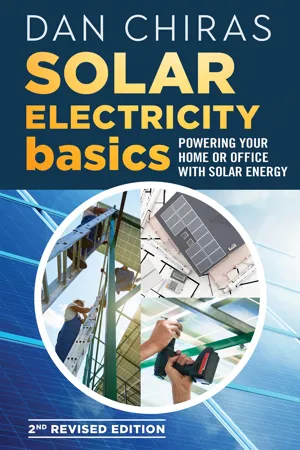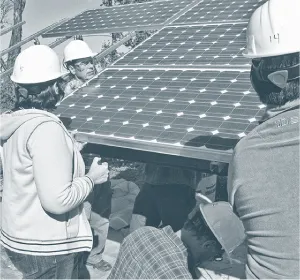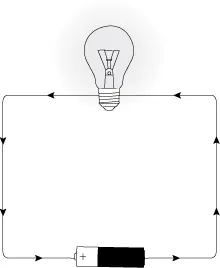![]()
CHAPTER 1
An Introduction to Solar Electricity
The world is in the midst of a global renewable energy revolution. With installations of new solar and wind energy systems climbing rapidly, nearly 50 countries have pledged to be 100% dependent on renewable energy by 2050. That’s no pipe dream. It’s highly doable. In fact, researchers at Stanford University project that the world could be 100% reliant on renewables in 20 to 40 years. The technologies and know-how are here, and in many parts of the world, so is the commitment.
Although the United States and Canada are not leading the race to a renewable energy future, significant progress is being made in both countries. In the US, for instance, solar, wind, biomass, hydroelectricity, and geothermal now produce about 17% of the nation’s electricity—up from 7 to 8 percent at the beginning of the millennium.
One reason why renewable energy production has increased in recent years in the US is declining cost. Because of this, solar electric systems now consistently generate electricity at or below the cost of power from conventional sources like nuclear power and coal. With federal tax credits that have been in place for over a decade, solar electric systems on homes and businesses consistently produce electricity much cheaper than utilities. Declining costs and rising popularity have led many utilities to install solar and wind farms.
In this book, we will explore solar electric systems, technically known as photovoltaic systems or PV systems, for short. I will primarily present information on residential-scale PV systems—systems suitable for homes and small businesses. These systems generally fall in the range of 1,000 watts for very small, energy-efficient cabins or cottages to 5,000 to 15,000 watts for typical suburban homes. All-electric homes could require even larger systems (on the order of 25,000 watts). Small businesses typically require much larger systems. Before we move on, though, what does it mean when I (or a solar installer) refer to a 10,000-watt system?
Sizing Solar Systems: Understanding Rated Power
Solar electric systems are sized by their wattage. As just noted, a home might require a 10,000-watt system. The wattage rating is known as the rated power of a system. Rated power is also known as rated capacity.
The rated power of a system is the rated power of the modules (frequently, but improperly, referred to as panels) multiplied by the number of modules in the system. If your system contains ten 300-watt solar modules, its rated power, or capacity, is 3,000 watts. A system with twenty 300-watt modules is rated at 6,000 watts. To simplify matters, installers and other professionals convert watts to kilowatts. So, a 10,000-watt system is a 10-kilowatt (or kW) system. That’s a shorthand measure based on the fact that kilo in scientific jargon means 1,000.
But what does it mean when I say a module’s rated power is 300 watts?
The rated power of a solar module is the instantaneous output of the module measured in watts under an industry-established set of conditions known as standard test conditions (STC). By carefully controlling the temperature of the modules and the intensity of the light they are exposed to, all manufacturers rate their modules similarly. That way, buyers like you know what they’re getting—as do installers and system designers. But what does it really mean that a module is rated at 300 watts?
Of course, most of us are familiar with the term watts. When shopping for light bulbs, for instance, we select them based on wattage. The higher the wattage, the brighter the bulb. We also compare microwave ovens and hair dryers by their wattage. The higher the wattage, the more energy these devices consume. In these and other electronic devices, wattage is a measure of power consumption.
Technically speaking, though, wattage is the rate of the flow of energy. The higher the wattage, the greater the flow. So, a 100-watt incandescent light bulb will use a lot more power each second it operates than a 12-watt LED light.
Watts is also used to rate technologies that produce electricity, such as solar modules or power plants. For example, most solar modules installed these days are rated at 275 to 300 watts. Power plants are rated in millions of watts, or megawatts; a typical coal-fired power plant produces 500 to 1,000 megawatts of power.
To test a solar module to determine its rated power, workers set it up in a room that is maintained at 77°F (25°C). A light is flashed on the module at an intensity of 1,000 watts per square meter. That’s equivalent to full sun on a cloudless day in most parts of the world. The module is arranged so that light rays strike it at a 90° angle, that is, perpendicularly. (Light rays striking the module perpendicular to its surface result in the greatest absorption of the light.) A 300-watt module will produce 300 watts of energy under such conditions.
To size a solar electric system, solar installers first determine the size of the system (in watts) a customer needs to meet his or her needs. (I’ll explain that process later.) They then divide that number—the rated power of the system—by the rated power of the modules they’re going to use. This simple math reveals the number of modules they will need to install. If a customer needs a 9,000-watt system, for instance, he or she would require thirty 300-watt modules.
An Overview of Solar Electric Systems
Now that you understand a little bit about solar system sizing, let’s take a look at solar electric systems.
Solar electric systems capture sunlight energy and convert it into electrical energy. This conversion takes place in the solar modules, more commonly referred to as solar panels. A solar module consists of numerous solar cells. Most solar modules contain 60 or 72 solar cells.
Solar cells are made from one of the most abundant chemical substances on Earth: silicon dioxide. It makes up 26% of the Earth’s crust. Silicon dioxide is found in quartz and a type of sand that contains quartz particles. Silicon for module construction is extracted from sand.
Solar cells are wired to one another in a module. The modules are encased in glass (on the front) and usually a thin layer of plastic sheeting (on the back) to protect the cells from the elements, especially moisture. Most modules have silver or black aluminum frames, although there are some frameless modules on the market, which were introduced for aesthetics and to simplify installation and reduce cost.
Two or more modules are typically mounted on a rack and wired together. Together, the rack and modules are known as a solar array. Ground-mounted arrays are usually anchored to the earth by a steel-reinforced concrete foundation. In such cases, the foundation is also considered part of the array.
Figure 1.1. These solar modules being installed by several students at The Evergreen Institute consist of numerous square solar cells. Each solar cell has a voltage of around 0.6 volts. The cells are wired in series to produce higher voltage, which helps move the electrons from cell to cell. Modules are also wired in series to increase voltage. Credit: Dan Chiras.
How Solar Cells and Modules Are Wired
Inside a solar module, solar cells are “wired” together in series. The modules in an array are then also wired in series. What does all this mean?
Series wiring is a technique commonly used in electrical devices. Batteries in a flashlight, for instance, are placed so that the positive end of one battery contacts the negative end of the next one. That’s series wiring. It’s done to increase the voltage. When you place two 1.5-volt batteries in series in a flashlight, you increase the voltage to 3 volts. Place four 1.5-volt batteries in series, and the voltage is 6.
So, what’s voltage?
Voltage is the somewhat mysterious force that moves electrons in wires and electrical devices. The higher the voltage, the greater the force.
In solar modules, each solar cell has a positive and a negative lead (wire). When manufacturing solar cells, the positive lead of one solar cell is soldered to the negative of the next, and so on and so on.
Most solar cells in use today are square and measure 5 × 5 inches (125 × 125 mm) or 6 × 6 inches (156 × 156 mm) and have a voltage of about 0.6 volts. When manufacturers wire (actually, solder) 60 solar cells together in series in a module, the voltage increases to 36. Seventy-two cells wired in series creates a 43-volt solar module.
Solar modules are themselves wired in series to further increase voltage. Ten 36-volt modules wired in series results in an array voltage of 360. Two more modules added to the series brings the voltage to 432 volts. Higher voltages allow us to transmit electricity more efficiently over greater distances.
A group of modules wired in series is known as a series string. Most residential solar arrays consist of one or more series strings, each containing 10 to 12 modules. String sizes in commercial PV arrays are larger.
Converting DC Electricity into AC Electricity
Solar modules produce direct current (DC) electricity. That’s the kind of electricity released by all batteries.
DC electricity is one of two types of electricity in use today. It consists of a flow of tiny subatomic particles called electrons through conductors, usually copper wires. In DC electricity, electrons flow in one direction (Figure 1.2). As illustrated, energized electrons stored in a charged battery flow out of the battery along a wire through a metal filament in a light bulb. Here, the energy of those electrons is used to create light and heat. The de-energized electrons then flow back into the battery.
In a solar system, DC electricity produced in the solar modules flows (via wires) to a device known as an inverter. Its job is to convert DC electricity produced by solar cells into alternating current (AC) electricity, the type of electricity used in homes and businesses throughout most of the world. In wires and devices that are powered by AC electricity, electrons flow back and forth—that is, they alternate direction very rapidly.
Figure 1.2. Solar electric systems produce direct current (DC) electricity just like batteries. As shown here, in DC circuits the electrons flow in one direction. The energy the electrons carry is used to power loads like light bulbs, heaters, and electronics. Credit: Forrest Chiras.
You may have noticed that the solar electric system I’ve just described has no batteries. Many people erroneously think that all solar systems include batteries. While that was true in earlier times, battery-based solar electric systems are extremely rare these days; they aren’t much needed anymore. The vast majority of systems in more developed countries are connected to the electrical grid—the wires that feed electricity to our communities. When a solar electric system is generating electricity, it powers the home or business. Any surplus electricity it produces is fed onto the grid, where it is consumed by one’s neighbors. However, the utility keeps track of that surplus and gives it back to the producer—you or me—free of charge whenever we need it. Although it’s a bit more complicated than this, you can think of the grid as a very large battery. (More on this later.)
Applications
Once a curiosity, solar electric systems are becoming commonplace throughout the world. Besides being installed on homes, they are now powering schools, small businesses, factories, and office buildings. Microsoft, Toyota, and Google are powered by large solar electric systems. More and more electric utilities are installing large PV arrays. In fact, utility-scale solar systems make up a large portion of the industry today.
Figure 1.3. This solar array was installed at the Owensville Middle School in Owensville, Missouri, by the author and his business ...




